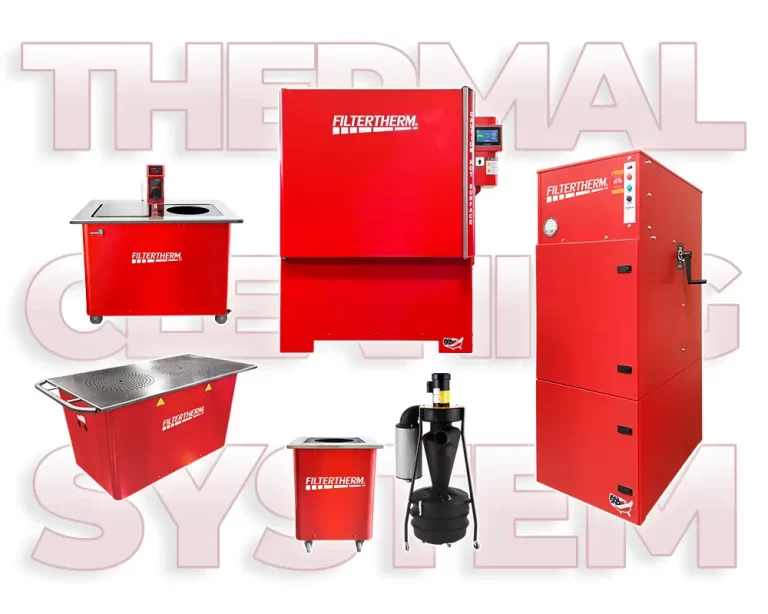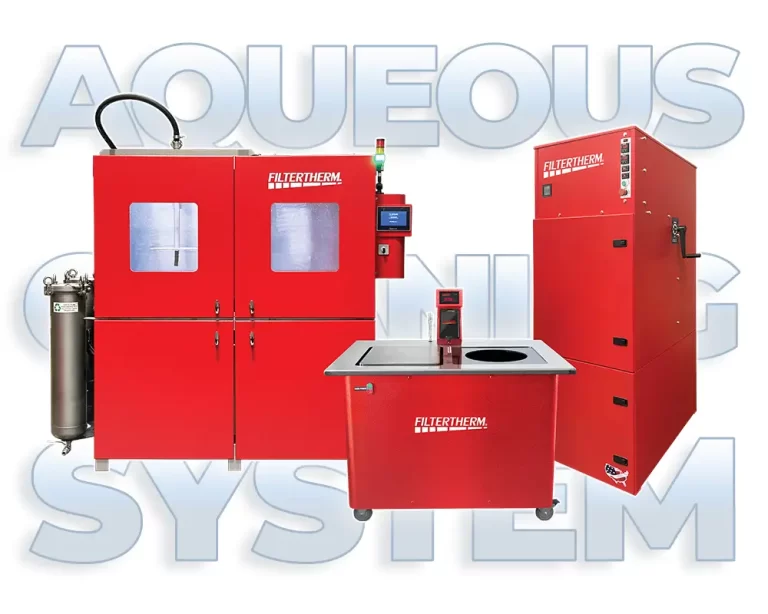Expert Recap: What is DPF REGEN?
Diesel engines are highly efficient and powerful, but their emissions contain high levels of pollutants such as particulate matter (PM) and nitrogen oxides (NOx), which are harmful to both human health and the environment. To address this, modern diesel engines are equipped with diesel particulate filters (DPFs) and diesel oxidation catalysts (DOCs). These devices work together to reduce emissions, but they require maintenance and regeneration to function effectively. So, what is DPF regen?
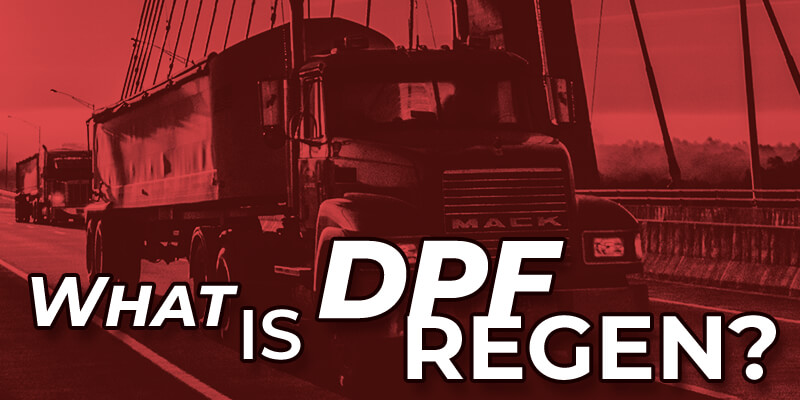
REGEN stands for Regeneration.
DPF Regen is:
the process by which the soot within a DPF is converted to ash through the use of heat, chemical reactions, and/or electricity. Soot combustion temperatures range from the 250˚C – 350˚C range (with a chemical or fuel catalyst) to the 550˚C range (without a catalyst).
In this article, we will cover the basics of DPF regeneration, the different types of aftertreatment filters, and what they do. We will also delve into the various types of regens, including passive regen, active-only regen, and passive-active regen. Finally, we will discuss DPF cleaning, which is necessary to remove accumulated soot and debris from the filter’s pores and ensure optimal engine performance while minimizing harmful emissions.
DPF REGENERATION
DPF regeneration is the process of burning off accumulated soot from the DPF to prevent it from clogging and reducing the engine’s performance. When the soot builds up, the DPF’s backpressure increases, which can lead to a loss of power and fuel efficiency. To regenerate the DPF, three methods are available: passive regeneration, active-only regeneration, and passive-active regeneration.
PASSIVE REGEN
happens while driving, without the driver initiating
Passive regeneration is a type of DPF regeneration that occurs naturally while driving. When the engine’s exhaust gases are hot enough, they burn off the accumulated soot in the DPF. The driver may notice a warning light on the dashboard indicating that the system is undergoing passive regeneration. During this process, the heated exhaust stream flows into the DPF and oxidizes the soot. This creates ash, which is removed by cleaning the DPF.
However, passive regeneration is not always effective, particularly in stop-and-go driving conditions where the exhaust gases are not hot enough to ignite the soot. If the warning light indicates passive regeneration, the driver should not park the vehicle in tall or dry grass and should continue driving if possible.
ACTIVE-ONLY REGEN
a regen that is initiated by the driver, does not happen automatically
Active-only systems are not as common, usually, in retrofit systems – they use diesel fuel or electricity as a heat source to oxidize soot; typically done while parked and is driver initiated.
PASSIVE-ACTIVE REGEN
most trucks have this type of regen capability
Trucks that utilize passive-active regeneration are able to both regen on the truck while driving down the road AND through forced regen initiated by the driver. Forced regen is required – let’s say – after the driver has sat in traffic for an extended amount of time and the “service DPF” light comes on…. this means the duty cycle isn’t hot enough for regeneration while driving down the road, so it’s prompting for the driver to manually initiate regen.
Diesel Particulate Filters (DPFs)
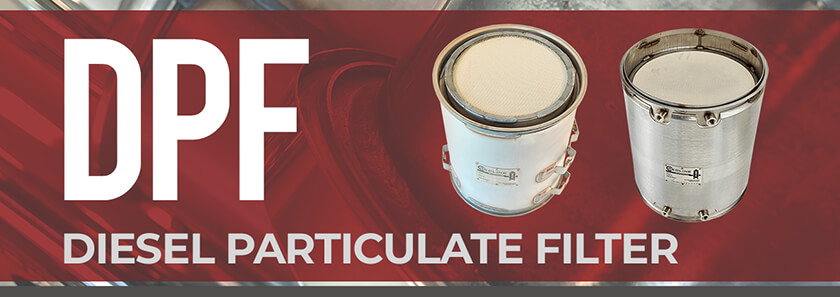
Diesel Particulate Filters (DPFs) are essential components of modern diesel engines. They are designed to capture and remove particulate matter, such as soot and other fine particles, from the engine’s exhaust gases. DPFs are required to have at least an 85% particulate matter reduction to meet increasingly stringent emissions regulations.
DPFs work by using a ceramic honeycomb structure with microscopic pores that trap and hold the particulate matter as exhaust gases pass through it. Over time, the pores in the DPF can become clogged with soot and other debris, reducing its effectiveness in capturing particulate matter and requiring cleaning.
DPF regeneration is necessary to remove accumulated soot and debris from the filter’s pores. As mentioned earlier, there are three types of DPF regeneration: passive regeneration, active-only regeneration, and passive-active regeneration.
Proper maintenance of the DPF is essential to prevent clogging and maintain the engine’s performance and fuel efficiency. A clogged DPF can lead to a loss of power and increased fuel consumption, while a malfunctioning DPF can lead to higher emissions of harmful pollutants. It is not always wise to follow the manufacturer’s maintenance schedules which are based on ideal operating/driving conditions. You should clean or replace the DPF when necessary to ensure the engine’s optimal performance. Real-world driving conditions can greatly affect the actual time between DPF cleanings. Lots of stop-and-go driving or idling conditions often cause the emissions system to clog up faster.
Based on years of cleaning DPFs in our own shops, we recommended a proactive service schedule of 1,000 engine hours, once a year or every 50,000 to 70,000 miles.
REP offers a full lineup of OEM replacement DPFs to help maintain your engine’s optimal performance.
Diesel Oxidation Catalysts (DOCs)
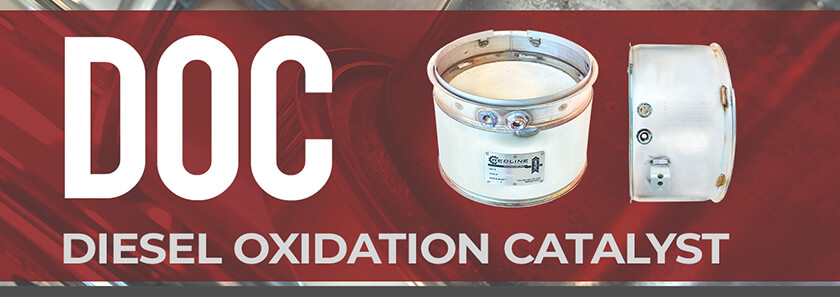
Diesel Oxidation Catalysts (DOCs) are crucial components of modern diesel engines that help reduce harmful emissions such as CO, HC, and NOx. A DOC is typically located before a DPF in the exhaust system, and its primary function is to create the correct environment for soot regeneration to occur within the DPF.
The DOC works by using a ceramic honeycomb structure coated with precious metals such as Platinum, Palladium, or Rhodium. The ceramic structure provides a large surface area for the chemical reaction to take place, while the precious metal acts as a catalyst to speed up the reaction. The chemical reaction converts harmful pollutants into less harmful substances, reducing emissions.
Proper maintenance of the DOC is essential to ensure optimal performance and longevity. Over time, the precious metal coating can become contaminated or degraded, reducing the DOC’s effectiveness in reducing emissions. A malfunctioning DOC can lead to higher emissions of harmful pollutants, decreased fuel efficiency, and engine performance.
To ensure optimal performance, it is essential to follow the manufacturer’s maintenance schedule and seek professional help when needed to maintain or replace the DOC. Regular maintenance, such as inspecting and cleaning the DOC, can help extend its lifespan and minimize harmful emissions, contributing to a cleaner environment. Based on years of cleaning DOCs in our own shops, we recommended a proactive service schedule of 1,000 engine hours, once a year or every 50,000 to 70,000 miles.
At REP, we offer a full lineup of OEM replacement DOCs to ensure that your diesel engine meets the latest emissions regulations and operates at its best. With our high-quality DOCs and expert support, you can maintain the performance and longevity of your engine while minimizing its environmental impact.
DPF CLEANING
“…the regeneration process doesn’t stop on the truck”
The on-truck regeneration process produces ash that can accumulate and eventually plug the DPF, leading to potential engine problems and poor fuel economy. This is why cleaning the DPF while off the truck is another type of regeneration process.
Unfortunately, on-truck regeneration doesn’t break down all of the soot in a diesel particulate filter, except under perfect conditions, which rarely exist. Removing the DPF from the vehicle and then cleaning it is the most consistent way of breaking down soot to ash and allows for proper operation of the DPF.
Proper maintenance of the DPF is crucial to ensure optimal performance and fuel efficiency. A clogged DPF can lead to a loss of power and increased fuel consumption, while a malfunctioning DOC can lead to higher emissions of harmful pollutants. It is essential to follow the manufacturer’s maintenance schedule and replace the DPF or DOC when necessary to ensure the engine’s optimal performance. Regular DPF cleaning can help extend the lifespan of the filter and prevent costly repairs.
In some cases, DPF cleaning may not be enough, and the filter may need to be replaced. This is often the case when the filter is severely clogged or damaged. DPF replacement can cost thousands, so it’s much better to start with proper maintenance and regular DPF cleaning.
There are two common ways to clean a DPF: thermal and aqueous. Thermal cleaning involves heating the filter to a high temperature to burn off the material, while aqueous cleaning uses a cleaning solution to dissolve and remove the material.
Thermal cleaning involves heating the DPF to a high temperature, typically between 500-600°C, to burn off the accumulated soot and other debris. The Thermal cleaning process usually is about a day. The baking cycle is often completed overnight and then it takes a few hours for the filters to cool down.
The centerpiece of the thermal system is the high-capacity DPF Oven from Filtertherm® This DPF Cleaning machine is designed to bake multiple filters safely & efficiently at once. Bake a batch of filters overnight & re-install them the next day. Thermal works well for standard-shaped DPFs, DOCs, SCRs, One-boxes, etc. If your fleet has a lot of odd-shaped filters, you may want to consider Aqueous (see below).
Aqueous cleaning involves using a special cleaning solution to dissolve and remove the accumulated soot and other debris from the DPF’s pores. The non-destructive water-based cleaning process does not compromise the substrate of a filter. The Aqueous cleaning process can usually be completed in just a couple of hours. Getting your trucks back on the road the same day is a game changer.
The Filtertherm® Aqueous DPF Cleaning Machine is the centerpiece of the system and is designed to handle filters of many sizes & shapes. There’s no need to cut open filters that have tapered inlets and/or outlets. Aqueous has adapters to accommodate many different shaped filters.
DPF REGENS ARE CRITICAL!
“DPF regeneration is an essential component of modern diesel engines.”
Proper maintenance of the aftertreatment system is necessary to ensure optimal performance, minimize harmful emissions, and extend the engine’s lifespan. Diesel particulate filters capture and remove particulate matter from the engine’s exhaust gases, while diesel oxidation catalysts reduce emissions of NOx, CO, and HC.
The method of DPF regeneration used depends on the driving conditions and the engine’s control module, with passive regeneration occurring naturally, while active-only regeneration and passive-active regeneration give more control to the driver. It is important to follow the manufacturer’s maintenance schedule and seek professional help when needed to maintain aftertreatment components and keep the engine running smoothly.
Want to find out about becoming a Redline Emissions Products® dealer? Or maybe you’re thinking about starting a DPF Cleaning business?
Contact Anthony Soto, National Sales Manager for REP to find out more. Call 888-295-4670
Need Tech Support or need help troubleshooting a DPF problem? No problem! Contact REP Support at 1-888-564-4209



